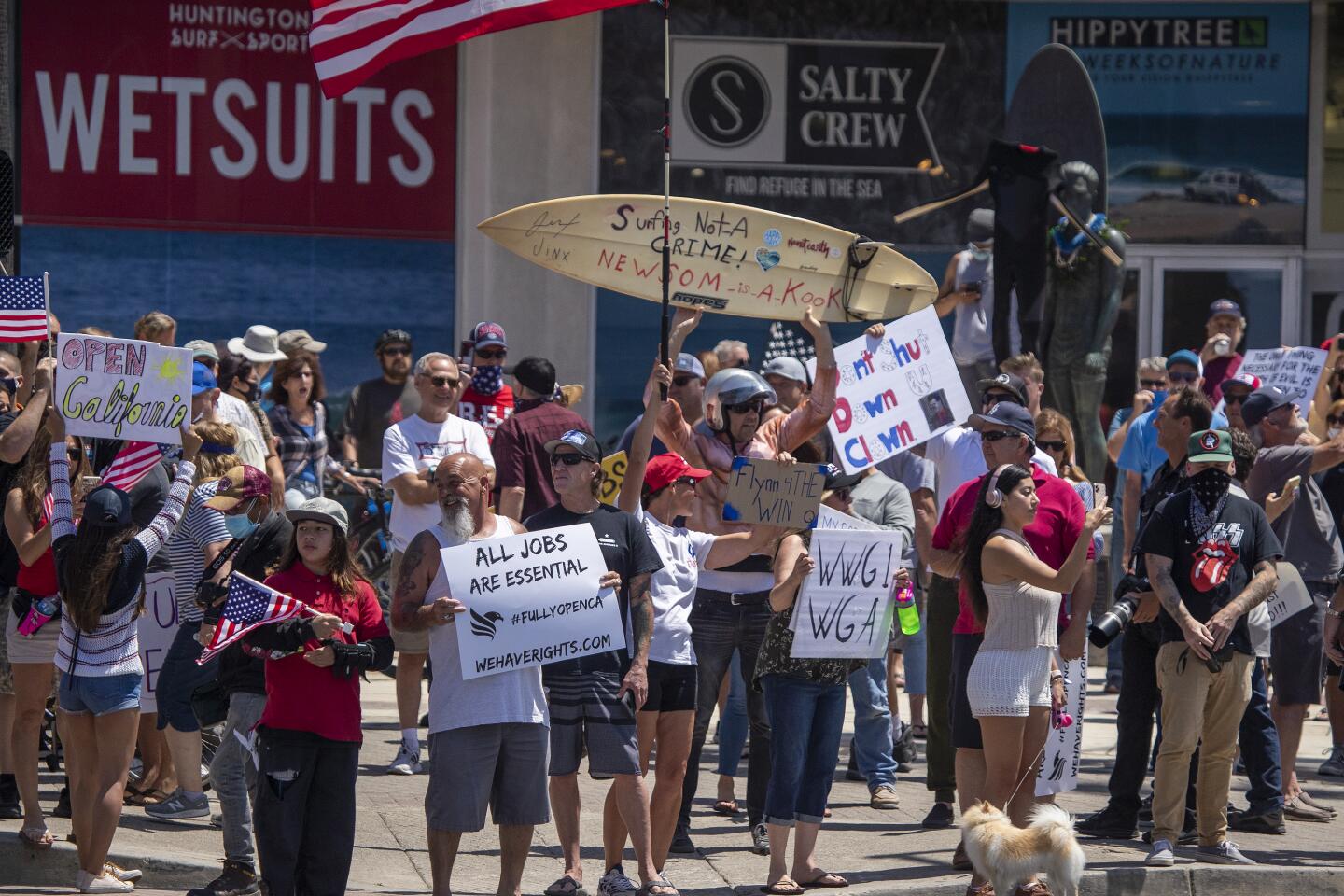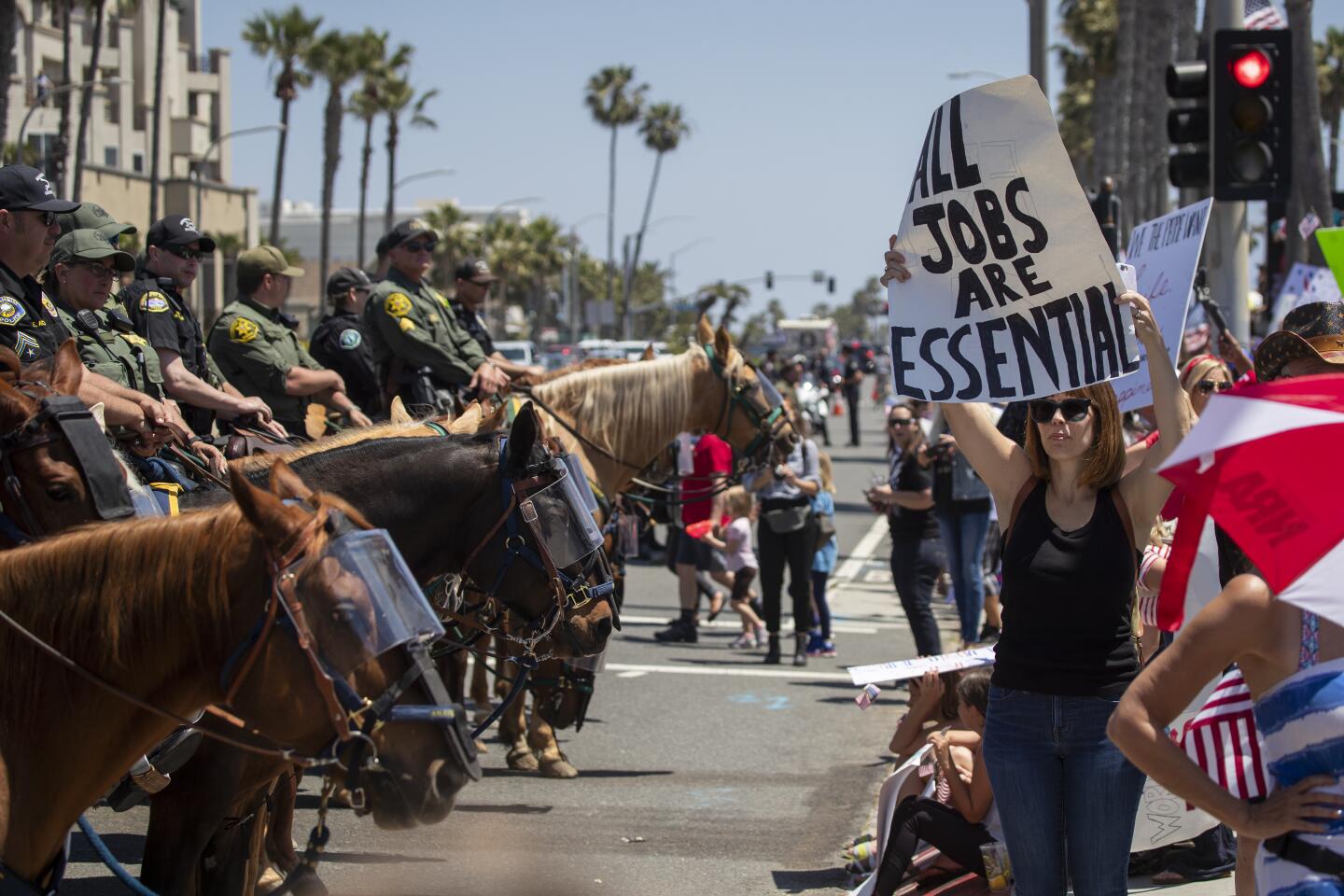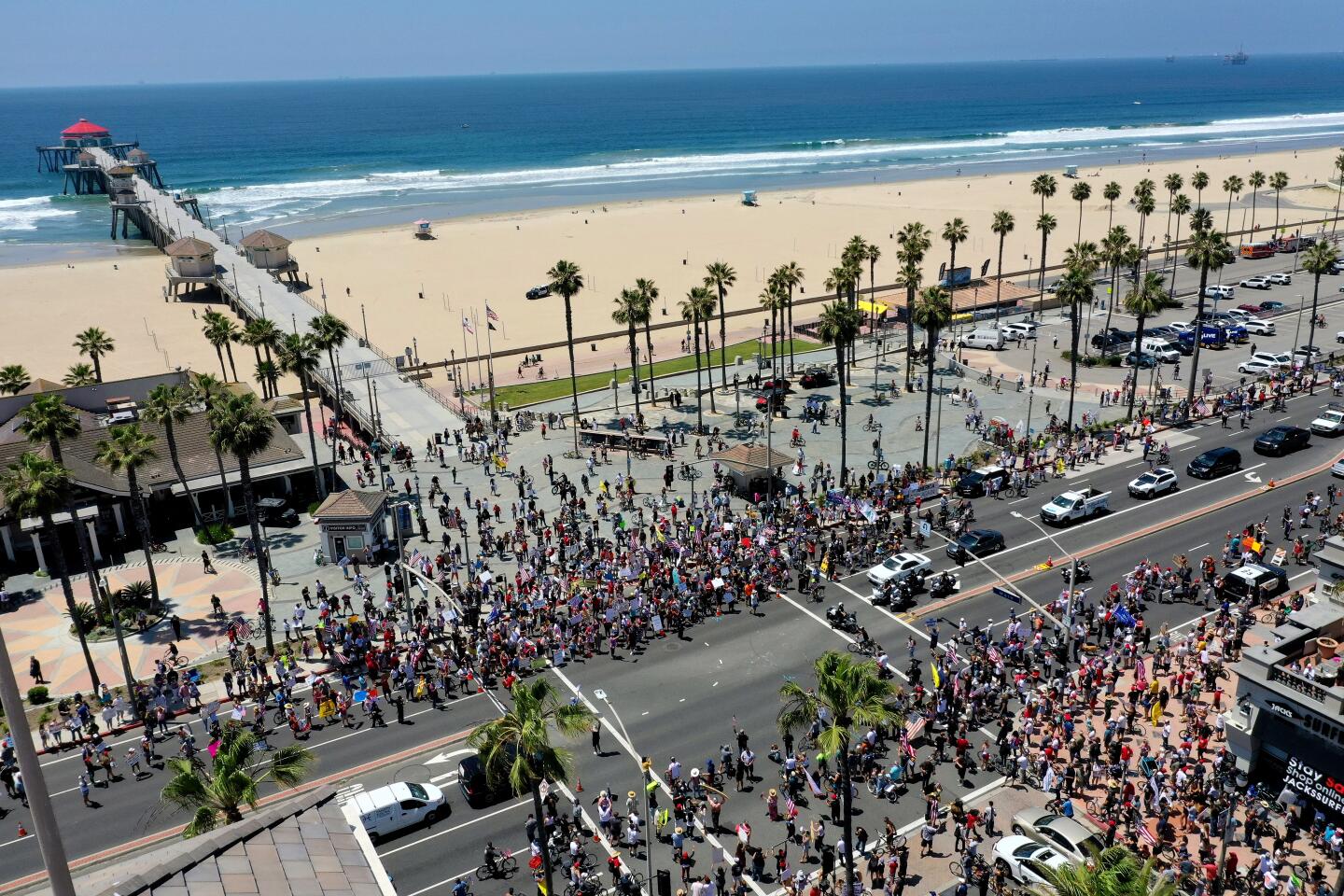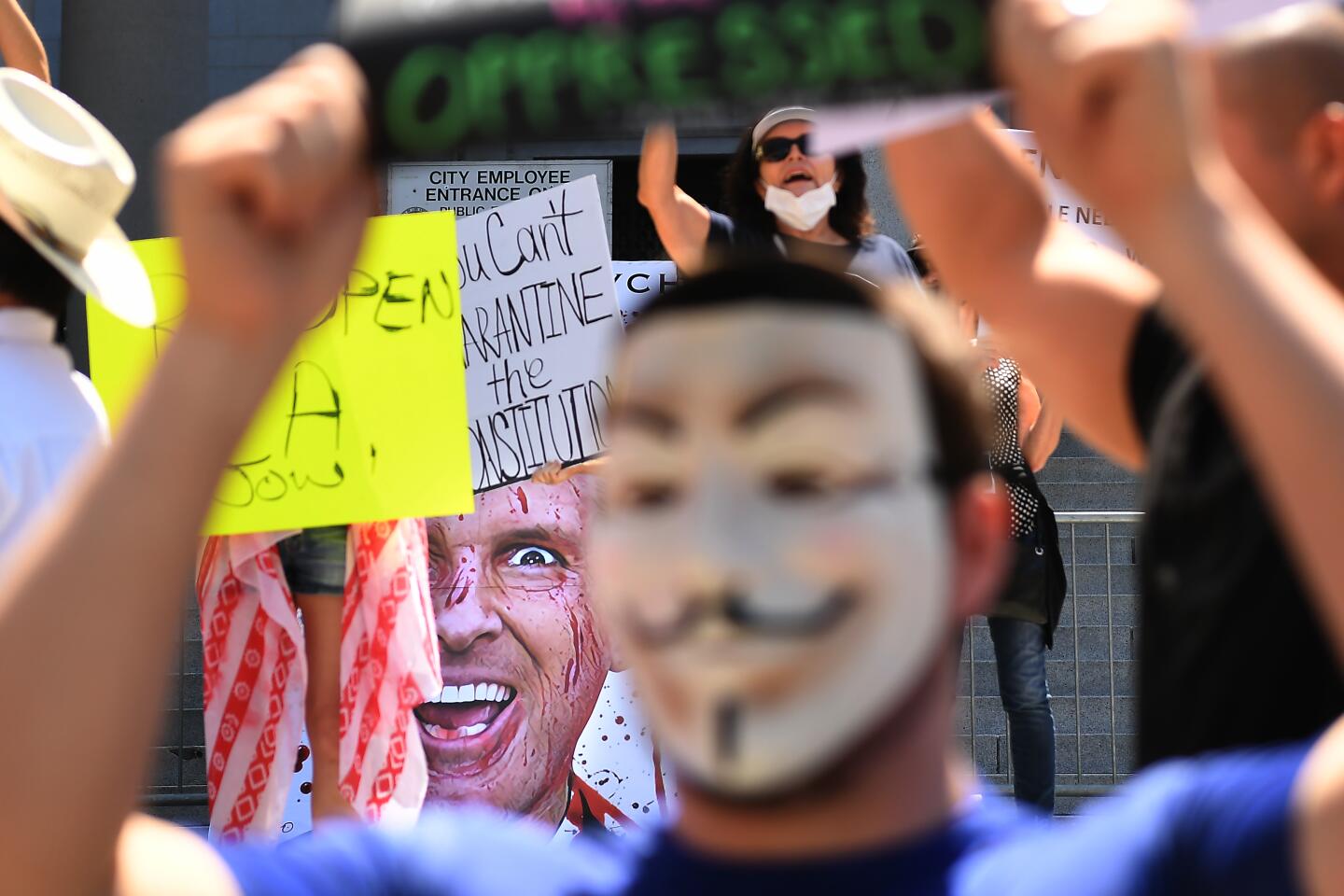California reopening would start slow, not be complete for a year or longer, expert estimates

So when might California be ready to really loosen up its statewide stay-at-home order?
One expert told The Times it would be a slow process that could take more than a year. But as some counties have pushed to reopen faster, Gov. Gavin Newsom is moving ahead with initial steps in the second stage of his previously outlined four-stage plan.
Newsom, who has said he understands frustrations with the projected pace of reopening, announced on Monday plans to allow some retail businesses to reopen as early as Friday for curbside pickup. And he said some counties would be able to move faster than others to reopen more types of businesses.
Some health experts on the local and national level have cautioned that some coronavirus restrictions — like sports teams not being allowed to play to packed stadium crowds — may need to continue through the rest of this year and into next year.
Los Angeles Times’ visual coverage of the coronavirus crisis
Dr. Deborah Birx, coordinator of the Trump administration’s corornavirus task force, also urged caution in reopening.
“Federal guidelines are a pretty firm policy of what we think is important from a public health standpoint,” Birx said on Fox News on Sunday. “As states reopen, we really want them to follow the gating criteria.”
Birx added that the American people needed to continue to practice social distancing.
California has not yet seen a steady two-week decline in coronavirus cases. The weekly number of cases appeared to flatten for several weeks in early April, with 8,000 to 8,500 cases every week. But from April 19 to 25, the state recorded 11,777 new cases, and in the seven days ending Saturday, 11,041 new cases were recorded.
California has started to see a week-over-week decline in deaths. Whether the trend will continue, however, is uncertain. From April 19 to 25, 547 coronavirus-related deaths were reported in California, and last week, 497 fatalities were reported, a 9% decrease in weekly deaths.
Here’s a rundown of the governor’s plan, and what one expert thinks of it.
The expert is Dr. Robert Kim-Farley, medical epidemiologist and infectious-disease expert at the UCLA Fielding School of Public Health. He’s also a former senior official for the Los Angeles County Department of Public Health, the U.S. Centers for Disease Control and Prevention, and the World Health Organization. From 2004 to 2018, he was Los Angeles County’s director of the Division of Communicable Disease Control and Prevention.
Stage 1: Continue with the stay-at-home order
This is the stage we’ve been in. The governor issued the first statewide stay-at-home order in the nation March 19, three days after six San Francisco Bay Area counties implemented the first shelter-in-place order in the country.
Dr. Sonia Angell, the state health officer, said it was the right time to talk about reopening the state, given that hospitalization rates for COVID-19 are stable in California. Some regions have already begun loosening local orders that were stricter than the state’s.
Expert forecast: By the end of May or into mid-June, Kim-Farley expects that places that have effectively maintained physical-distancing measures will see significant reductions in the numbers of cases. He also suspects that, around this time, there will be enough capacity to offer tests for the virus and antibodies — to determine whether people may have some immunity — to meet the demand.
More than 2,200 Californians have died and more than 54,000 have been confirmed as having been infected with the coronavirus. Los Angeles County has the most deaths of any of California’s 58 counties — more than 1,200, or over 55% of the state’s total — even though it represents one-quarter of the state’s population.
Stage 2: Gradual opening of lower-risk workplaces
Opening up with new restrictions:
- Retail, with adaptations, like offering curbside pickup
- Factories, such as those that manufacture toys, clothing and furniture
- Offices, where telecommuting is not possible, but with modifications to lower risk
- Modified school and child-care programs reopen
Expert forecast: Kim-Farley said last week he suspected California would be headed to Stage 2 in mid-June through the month of July. Kim-Farley said the government’s moves could come sooner or later, depending on the status of the pandemic.
On Monday, Gov. Gavin Newsom, faced with calls to reopen faster by officials in sparsely populated counties that have not been hit hard by the pandemic, picked up the pace. State officials said the number of people hospitalized with COVID-19 continued to be stable and show some initial signs of decreasing.
Newsom said some initial parts of Stage 2 would begin as soon as Friday — such as allowing curbside pickup at nonessential stores that had been ordered shut, including bookstores, clothing stores, music stores, toy stores, florists, sporting goods retailers.
Factories that supply those businesses also would be allowed to resume. He said more-detailed guidelines on the businesses that could reopen would be released Thursday.
San Francisco’s director of public health, Dr. Grant Colfax, said florists could make deliveries in time for Mother’s Day.
Other parts of Stage 2 are still on hold — offices, shopping malls, and seated dining at restaurants are still ordered shut.
Counties can choose to accelerate reopening of businesses in Stage 2 — “not into Phase 3 yet but well into Phase 2,” Newsom said. To accelerate their moves through Stage 2, counties would need to have their plans certified by the local health official along with their county board of supervisors, Newsom said, which would permit openings — with coronavirus modifications — of seated dining at restaurants and the opening of more hospitality businesses.
Newsom said areas that chose to go slower in reopening businesses, like the San Francisco Bay Area, could still do so. Pandemic conditions vary widely throughout the state, Newsom said.
Some counties — Modoc, Yuba and Sutter counties in Northern California — have defied Newsom’s orders and allowed more or all kinds of businesses to reopen. Newsom declined to say on Monday whether there would be consequences for those counties but said the overwhelming majority of California’s 58 counties were doing the right thing.
There are potential risks for businesses that reopen in accordance with local orders but are still at odds with the state order. Officials in Yuba and Sutter counties suggested business owners in this gray area contact legal counsel for advice before proceeding.
Newsom said some 80 bars in California that reopened shut down again after state officials threatened to pull their operating licenses.
In Los Angeles County, the public health director, Barbara Ferrer, said Monday that officials would be sharing publicly recovery plans this week, and said “wherever it’s possible to safely reopen, we’ll be doing so as quickly as possible.”
San Francisco Mayor London Breed on Monday said she could not say definitively what kinds of businesses could resume opening on Friday. “We have to do so responsibly,” Breed said. “It is important that we rely on the facts, we rely on the data, we rely on the advice of our county health officers.”
Stage 3: Opening of higher-risk workplaces
There will need to be much more modification to these workplaces to make them safer, state health officer Angell said last week. “We need to know much more about the movement of disease to be able to make data-informed decisions about what’s safe for folks,” Angell said.
- Hair and nail salons
- Gyms
- Movie theaters
- Sports without live audiences
- Churches
- Weddings
Expert forecast: In general, Kim-Farley suspects Stage 3 may occur around August or September — sometime in the late summer or early fall. He expects social-distancing measures — like wearing face coverings and limiting the number of people inside a store — to continue.
Again, the timing could be earlier or later, depending on how the pandemic is progressing.
Stage 4: Full opening
The full end of the stay-at-home order, allowing the resumption of:
- Sports with live audiences
- Convention centers
- Concerts
Expert forecast: This may not be implemented until the middle or latter part of 2021, Kim-Farley said.
Dr. Anthony Fauci, director of the National Institute of Allergy and Infectious Diseases, has said that, even under the most optimistic scenarios, it would take 12 to 18 months for a vaccine to become available.
Last week, Fauci said it might not be possible for sports teams to resume play this year.
“Safety, for the players and for the fans, trumps everything,” Fauci said in an interview with the New York Times. “If you can’t guarantee safety, then unfortunately you’re going to have to bite the bullet and say, ‘We may have to go without this sport for this season.’”
More to Read
Sign up for Essential California
The most important California stories and recommendations in your inbox every morning.
You may occasionally receive promotional content from the Los Angeles Times.










































